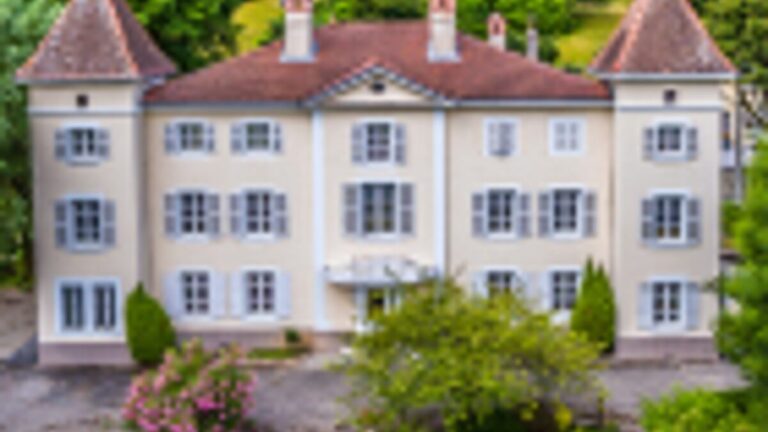Château de la Sône: A Historic Fortress and Residence in La Sône, France
Visitor Information
Google Rating: 3.8
Popularity: Very Low
Google Maps: View on Google Maps
Official Website: chateaudelasone.fr
Country: France
Civilization: Unclassified
Remains: Military
History
The Château de la Sône is situated in the commune of La Sône in modern-day France. Its origins trace back to the Gaulish period, when the site served as an oppidum—a fortified settlement—perched on a rocky outcrop overlooking the Isère River. This early strategic location later developed into a fortified house, first mentioned in 1210 through imperial letters patent issued by Emperor Otto IV, which confirmed the Abbey of Montmajour’s rights over the land.
In the early 14th century, Ardanchon de la Reffrairie undertook significant expansion and reinforcement of the fortress, solidifying its defenses. During this period, he paid homage to Humbert, the last Dauphin of Viennois, reflecting the local feudal relationships of the time. Later, in 1448, the future King Louis XI resided at the château during a hunting trip in the surrounding area, indicating its stature within noble circles.
The 16th century brought considerable turmoil as the château became a contested site during the Wars of Religion between Catholics and Protestants. It suffered serious damage and was notably besieged by the military leader Lesdiguières. In 1603, Félicien de Boffin, a legal officer from Grenoble, purchased the estate. He restored the war-torn buildings and carried out extensive remodeling, especially of the main residence and the west tower. The Boffin family held the property for nearly 200 years, firmly establishing their presence.
By the 19th century, ownership shifted to the Jubié family, known for their involvement in silk manufacturing. Financial difficulties during industrial decline caused an unsuccessful attempt to sell the property in 1848. Subsequently, the château passed through several hands, including the Baron de Jarente in 1875, Dr. Collignon in 1890, Thomas Huss in 1931, and eventually the Morel family in 1952.
Between 1952 and 1975, Charles and Viola Morel undertook significant restoration efforts without receiving public funding. Their work included repairs to the roofs, modernization of utilities, enhancement of the gardens, and refurbishment of interior spaces. The château became a venue for cultural gatherings under their stewardship. Ownership transferred to M. Pons after 1976, who focused on restoring the château’s glazed tiled roofs.
In 2017, Clothilde Vermont acquired the estate and has since overseen comprehensive restoration projects addressing structural repairs and interior decoration. These efforts continue to be supported privately. The surrounding park sustained severe damage during a storm in 2019 but has been actively restored. Throughout its history, the château has remained a private residence and is not open for public visits.
Remains
The Château de la Sône occupies a prominent position atop a rocky outcrop, featuring a blend of medieval and later architectural elements arranged on a terrace overlooking the Isère River. The most ancient surviving structure is a tall tower dating from the late 14th century. This tower is characterized by machicolations—openings through which defenders could drop objects or pour substances onto attackers—supported by projecting stone corbels along the parapet. This defensive feature reflects medieval military architecture focused on fortification and protection.
Adjacent to the tower, the principal residential building dates from the 16th century, corresponding to renovations that followed the conflicts of the Wars of Religion. This main structure was later renovated in the late 19th century to update and preserve its form. The building’s façades and roofs have been formally designated as historic monuments, recognizing their architectural significance and historic continuity.
Within the château grounds stands a chapel that contains decorative paintings from the 17th century. These artworks contribute to the site’s cultural heritage, reflecting artistic tastes and religious devotion during the post-war remodeling phase initiated by Félicien de Boffin.
Surrounding the château, the park covers roughly four hectares and is thought to have been designed in the 17th century under Félicien de Boffin’s direction. It features a rock garden positioned opposite the access bridge, adding a naturalistic aesthetic to the formal layout. A notable plane tree-lined avenue flanks a lawn with a circular basin fashioned in the style of Louis XIV’s gardens, emphasizing symmetry and classical motifs. The park’s belvedere offers panoramic views over the Isère River and the nearby village, integrating landscape and architecture.
Further into the park’s rear area, centuries-old trees like tulip trees, ginkgo, yews, sequoias, purple beeches, cedars, and sophora create a diverse arboreal environment. A winding path leads back toward the château through sections planted with more recent species, such as purple hazelnuts, soap trees, ornamental apple trees, and liquidambars, illustrating ongoing botanical development.
Restoration efforts over time have included the repair of the château’s glazed tile roof, addressing previous leaks, alongside the refurbishing of principal interior spaces like the grand salons, the kitchen, and the caretaker’s house. Both the château’s structural elements and its park are officially protected as historic monuments, ensuring the preservation of their historical and natural character for the future.







